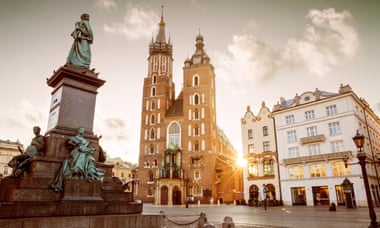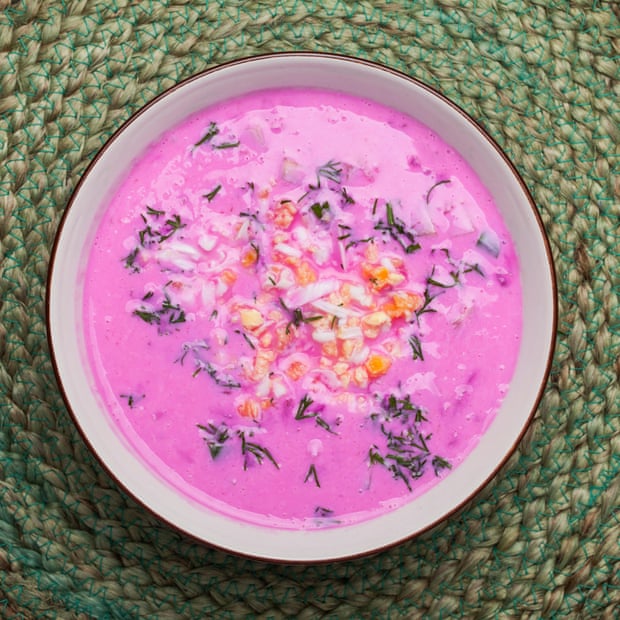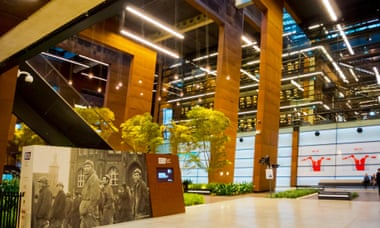I first visited Poland when travel restarted after lockdown. Going somewhere unfamiliar is invigorating: fresh air for the brain. It is one reason why we travel. And after months embalmed at home, I wanted to feel the joy again of roving through city parks and dabbling in food overseas. Poland felt right – for its proximity, affordability and, most of all, for me at least, its cuisine.
During lockdown I’d become fascinated by Polish food culture. I’d travelled vicariously to Poland’s pine forests and Baltic coastline with Polska: New Polish Cooking (Quadrille, 2016), a book by Zuza Zak, a “storyteller cook”. Born in the Mazowsze region in north-eastern Poland, she is brilliant at challenging misconceptions about the food of her homeland. Yes, it is hearty, but it is also fresh and complex, with pickles, berries, cheeses, game, fish and herbs. Through wine-spattered pages, I’d learned to make rose petal jam doughnuts, sauerkraut slaws, and mackerel baked with cherries.
Curiosity had also been sparked by reading Pan Tadeusz, an epic poem by Adam Mickiewicz (1798-1855). In the book, he describes bigos, Poland’s ultimate wintertime stew, historically made in forest clearings where hunters would drop their game into a pot simmering with pickled fruit: “In the pots warmed the bigos; mere words cannot tell / Of its wondrous taste, colour and marvellous smell.”

I wanted to try those flavours in situ during a quick taster trip to three cities: Warsaw, Kraków and Gdańsk. And I did. But before we get to that, I want to say that I’ve just returned from Poland once again. I took a short trip to Warsaw during a gap between fundraising events for Ukraine, which I’ve been involved with since Russia’s invasion began. And I learned that food aside, there is now another pressing reason to go. Poland is making enormous efforts to assist Ukrainians, still arriving in their thousands by bus and train every day (around 1.2 million have applied for temporary residence in Poland). Giant tented kitchens are operating around the clock at railway stations, hotels are hosting refugees, cafes are raising money, chefs are delivering meals and museums and galleries all have donation boxes. There is an intense atmosphere of solidarity. For every Polish flag flying, there is a Ukrainian one.
The question is, does it feel right to be a “tourist” at a time like this? I would say absolutely, yes. By spending money in Poland you are directly supporting those helping Ukrainians – hotel owners who are offering free stays to those who have fled, restaurant chefs delivering free meals to refugee centres, and ordinary Poles, from shop owners and waiters to bartenders and taxi drivers, who have offered millions of refugees a place to sleep in their homes. At art galleries and museums there are QR codes to scan to donate to charities and boxes to drop cash in. In many cafes the price of your cappuccino is donated to Ukrainian charities. The generosity here is heartfelt and moving.

During that first post-lockdown visit, I fell for Warsaw immediately, walking for hours through the elegant grounds of Łazienki Park, with its ornate follies, lakes and pavilions. By the park’s botanical gardens, Flora Caffé pulled me in with its sun-drenched wicker chairs. Turning down the waiter’s suggestion of szarlotka, apple cake, I asked instead for a plate of seasonal fruit.
“Berries? We only have berries.”
“Perfect, thank you.”
Under a thick slice of sun, I devoured this small hillock of naked Polish blueberries, raspberries and strawberries. They were the best I’d ever eaten, each one a grenade of flavour, as superior tasting as wine. I quickly sought them out in other ways, mainly in soups, which Poland excels at. I loved the unexpected sour-sweetness of a hot tomato and raspberry soup at Pyszna i Próżna and the cooling blueberry pierogi (dumplings) eaten at the old-school Radio Café, owned by Stanisław Prószyński, a journalist who – now well into his 80s – has pinned up anti-Putin posters.

On my first day, I stopped, too, at the grand National Museum, crammed with 800,000 items. One curiosity in particular stood out: a glittering 18th-century travelling medicine chest with writing accessories, made from ruby glass, silver and velvet. What a timely, if cumbersome, accessory for wandering, pandemic-age writers, I thought.
The following day I bought a ticket for Kraków at Warsaw’s Central train station, where departure boards, showing Prague and Berlin, gave rise to ideas of future adventures. Seated in the comfortable carriage, the scenery quickly turned from tower blocks to Polish pastoral: fields green with summer, bisected by fast-running streams. Time slowed right down until three hours later, almost too soon, we arrived in Kraków. Navigating tight lanes and secretive corners, past pubs with charming names such as Dog in the Fog, I came upon the medieval main square and a towering statue of Adam Mickiewicz, which reminded me of the bigos I was yet to try.
Eager, I decided to split dinner: savoury at one place, sweet at another. The bistro Kielbasa I Sznurek, or Sausage and String, looked inviting, with a menu “directed” by Magda Gessler, an authority on Polish gastronomy. I started with a dill-heavy bowl of cold beetroot soup, chłodnik, and as Poland’s famous sausages are vegetarian too, nowadays, I tried the black lentil, buckwheat and linseed ones; then a plate of complex, but not heavy, bigos cooked with beef, wild mushrooms, smoked plums and red wine. Many of the ingredients had been gathered from nearby Stary Kleparz, an 800-year-old market, which in summer smells of lavender. For pudding, I headed to Jama Michalika, a short walk away, where under a stained glass art nouveau window depicting a peacock, I surprised myself by demolishing a gigantic ice-cream sundae, topped with advocaat.

A bugle woke me the next morning, and, following shuffling nuns dressed in grey habits, I went along narrow cobbled lanes, through Kraków’s compact centre, which encourages aimless wandering. I soon found the dimly lit Massolit bookshop, where inside I lost hours browsing paperbacks before settling into their cafe, a space so appealing – with elegant wallpaper, armchairs and customers quietly writing (with pens! On paper!) – that I thought I might stay for ever. But it was time to move on. Getting to the Baltic port city of Gdańsk involved a quick stop back in Warsaw, but the train north from there is easy – three hours or so.
In Gdańsk, I headed straight to the European Solidarity Centre, a hulking cultural institution, spread over five storeys, brimming with intense exhibitions – utilising everything from old lockers and typewriters to 3D projections – all helping to tell the story of Poland’s struggle for freedom. From the observation deck I could see shipyard cranes and the former Lenin shipyard, where dissent in the 1970s and 80s led to resistance and the Solidarity movement that contributed to the eventual collapse of communist rule in Poland and the entire eastern bloc.

Undoubtedly the must-see place in Gdańsk, it is also a lot to take in; so that night I sat down to think about it all at cosy-looking Fino. With a glass of crisp white wine from north-west Poland, I ordered pickled red cabbage butter for sourdough bread, spicy fish soup, zander from Poland’s northern lakes in a caviar sauce, and almond ice-cream with strawberry soup. It was all so good that the next day I took a little commuter train to nearby Gdynia, on the Baltic coast, to try their sister restaurant, Osteria Fino, for lunch (very good, too, but not as good).
I left Gdańsk nurturing a strong fascination for Poland and its long culinary culture. And, after my recent trip to Warsaw, I’ve plans to return again, as soon as possible, to spend my money where it can make a difference while I can, in Lublin, Poznań and Wrocław, for bakeries, berries and the best soups in the world.
For more ideas on what to do and where to eat in Poland, see inyourpocket.com